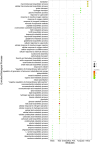Global transcriptome analysis identifies critical functional modules associated with multiple abiotic stress responses in microalgae Chromochloris zofingiensis
- PMID: 39172989
- PMCID: PMC11341014
- DOI: 10.1371/journal.pone.0307248
Global transcriptome analysis identifies critical functional modules associated with multiple abiotic stress responses in microalgae Chromochloris zofingiensis
Abstract
In the current study, systems biology approach was applied to get a deep insight regarding the regulatory mechanisms of Chromochloris zofingiensis under overall stress conditions. Meta-analysis was performed using p-values combination of differentially expressed genes. To identify the informative models related to stress conditions, two distinct weighted gene co-expression networks were constructed and preservation analyses were performed using medianRankand Zsummary algorithms. Moreover, functional enrichment analysis of non-preserved modules was performed to shed light on the biological performance of underlying genes in the non-preserved modules. In the next step, the gene regulatory networks between top hub genes of non-preserved modules and transcription factors were inferred using ensemble of trees algorithm. Results showed that the power of beta = 7 was the best soft-thresholding value to ensure a scale-free network, leading to the determination of 12 co-expression modules with an average size of 128 genes. Preservation analysis showed that the connectivity pattern of the six modules including the blue, black, yellow, pink, greenyellow, and turquoise changed during stress condition which defined as non-preserved modules. Examples of enriched pathways in non-preserved modules were Oxidative phosphorylation", "Vitamin B6 metabolism", and "Arachidonic acid metabolism". Constructed regulatory network between identified TFs and top hub genes of non-preserved module such as Cz06g10250, Cz03g12130 showed that some specific TFs such as C3H and SQUAMOSA promoter binding protein (SBP) specifically regulates the specific hubs. The current findings add substantially to our understanding of the stress responsive underlying mechanism of C. zofingiensis for future studies and metabolite production programs.
Copyright: © 2024 Bahman Panahi. This is an open access article distributed under the terms of the Creative Commons Attribution License, which permits unrestricted use, distribution, and reproduction in any medium, provided the original author and source are credited.
Conflict of interest statement
The authors have declared that no competing interests exist.
Figures






Similar articles
-
Weighted gene co-expression network analysis of the salt-responsive transcriptomes reveals novel hub genes in green halophytic microalgae Dunaliella salina.Sci Rep. 2021 Jan 15;11(1):1607. doi: 10.1038/s41598-020-80945-3. Sci Rep. 2021. PMID: 33452393 Free PMC article.
-
Comparative analysis of waterlogging and drought stress regulatory networks in barley (Hordeum vulgare).Funct Plant Biol. 2025 Feb;52:FP24051. doi: 10.1071/FP24051. Funct Plant Biol. 2025. PMID: 39960829
-
Systems biology approach identifies functional modules and regulatory hubs related to secondary metabolites accumulation after transition from autotrophic to heterotrophic growth condition in microalgae.PLoS One. 2020 Feb 21;15(2):e0225677. doi: 10.1371/journal.pone.0225677. eCollection 2020. PLoS One. 2020. PMID: 32084664 Free PMC article.
-
Trancriptome data mining in combination with co-expression network analysis identifies the functional modules and critical regulators in Hordeum vulgare L. in response to cold stress.Biochem Biophys Rep. 2023 Dec 20;37:101620. doi: 10.1016/j.bbrep.2023.101620. eCollection 2024 Mar. Biochem Biophys Rep. 2023. PMID: 38155945 Free PMC article.
-
Transcriptome meta-analysis-based identification of hub transcription factors and RNA-binding proteins potentially orchestrating gene regulatory cascades and crosstalk in response to abiotic stresses in Arabidopsis thaliana.J Appl Genet. 2024 May;65(2):255-269. doi: 10.1007/s13353-024-00837-4. Epub 2024 Feb 10. J Appl Genet. 2024. PMID: 38337133 Review.
Cited by
-
Unveiling the role of IL7R in metabolism-associated fatty liver disease leading to hepatocellular carcinoma through transcriptomic and machine learning approaches.Discov Oncol. 2025 May 23;16(1):873. doi: 10.1007/s12672-025-02638-5. Discov Oncol. 2025. PMID: 40408005 Free PMC article.
-
Integrative analysis of co-expression networks and codon usage bias in maize under biotic stress.PLoS One. 2025 Jul 23;20(7):e0317755. doi: 10.1371/journal.pone.0317755. eCollection 2025. PLoS One. 2025. PMID: 40700398 Free PMC article.
-
Analysis of Stress Response Genes in Microtuberization of Potato Solanum tuberosum L.: Contributions to Osmotic and Combined Abiotic Stress Tolerance.Plants (Basel). 2024 Oct 26;13(21):2996. doi: 10.3390/plants13212996. Plants (Basel). 2024. PMID: 39519915 Free PMC article.
-
Unveiling functional module associated with fungal disease stress in barley (Hordeum vulgare).Biochem Biophys Rep. 2025 Feb 20;41:101958. doi: 10.1016/j.bbrep.2025.101958. eCollection 2025 Mar. Biochem Biophys Rep. 2025. PMID: 40065769 Free PMC article.
References
-
- Razeghi J, Pishtab PA, Fathi P, Panahi B, Hejazi MA. The feasibility of microalgae Dunaliella identification based on conserved regions of mitochondrial cytochrome b and cytochrome oxidase genes. Cytology and Genetics. 2021;55(6):558–65.
-
- Panahi B, Farhadian M, Hejazi MA. Systems biology approach identifies functional modules and regulatory hubs related to secondary metabolites accumulation after transition from autotrophic to heterotrophic growth condition in microalgae. Plos one. 2020;15(2):e0225677. doi: 10.1371/journal.pone.0225677 - DOI - PMC - PubMed
MeSH terms
Substances
LinkOut - more resources
Full Text Sources

